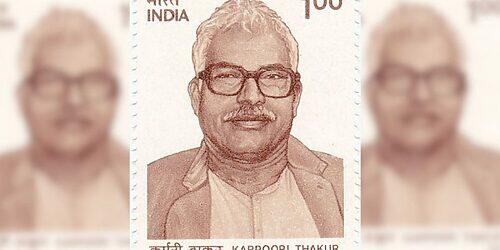
Karpoori Thakur. Photo: X/@IrfanUllahAns
But Thakur – a leader hailing from the Hajjam (barber) community – had noted that there existed a layer among the upper backward castes and lower backward castes. Thus, his government provided 12% reservation to the relatively weaker sections, against an 8% quota for the relatively well-off sections within the backward classes. Eventually, Prime Minister V.P. Singh would implement the Mandal Commission report in 1990. There was a striking similarity in the manner in which the Sangh Parivar had opposed Karpoori Thakur in 1978 and V.P. Singh, in 1990. Then BJP president, L.K. Advani, embarked on the Rath Yatra to counter the Mandal Commission report and the then Bihar chief minister and Thakur’s protégée, Lalu Prasad Yadav, had him arrested. This set off what became the ‘Mandal versus Kamandal’ battle in the Hindi heartland. Bharat Ratna and Ram Temple In fact, the purpose for which Advani had embarked on the Rath Yatra in 1990 and that for which Prime Minister Narendra Modi – who led the consecration at the Ram temple in Ayodhya on January 22 – conferred the Bharat Ratna on Karpoori Thakur is the same. Advani had begun his Rath Yatra to break into the backward classes mobilised in favour of Lalu Prasad Yadav in Bihar and Mulayam Singh Yadav in Uttar Pradesh – two champions of the Mandal Commission – who were in the vanguard of then anti-Hindutva politics. The Yatra was aimed at gaining the support of the backward classes in the name of Ram and organising them under the larger Hindu identity, against Muslims. Advani’s experiments succeeded to an extent in the sense that the BJP followed up with a brand of social engineering that brought several OBC leaders into the Hindutva fold over the years. This social engineering led the BJP to gain the support of several backward and marginalised caste groups in the Hindi heartland. Now, simultaneously with the consecration at the Ram temple at Ayodhya, the President of India has conferred Bharat Ratna, posthumously, on Karpoori Thakur. The optics of Modi who has consistently opposed a caste census – a consistent demand of parties of the Indian National Developmental Inclusive Alliance or INDIA – conferring the highest civilian award on Thakur to smother the narrative against Hindutva politics is clear to see. While fuelling a frenzy in the name of Ram in the run up to the 2024 elections, the BJP has been working assiduously to appropriate the legacy of the movement for social justice.

Narendra Modi with L.K. Advani during Advani’s rath yatra. Photo: Twitter
Nitish Kumar’s Janata Dal (United) had organised a mega event on January 24 – the 100th birth anniversary of Thakur – to celebrate his legacy. Meanwhile, the BJP which has been hostile to Thakur’s philosophy so far, also organised a function on Thakur’s birth anniversary, in Patna. Lohia and social justice: A person believed to be the original progenitor of the social justice movement in north India is Ram Manohar Lohia. It was Lohia who first demanded reservation for the backward classes in the light of the Kaka Kalelkar report in 1953. “Sansopa ne baandhi gaanth, pichara paave sau mein saath” – the Samyukta Socialist Party is determined to ensure 60% share of the backward classes in the governance structure – was the slogan fashioned by the SSP with Lohia as its leader in the 1960s. Thakur had emerged as the torch bearer of Lohia’s political legacy that incubated and shaped the political visions of Lalu Prasad Yadav and Nitish Kumar eventually. Lalu and Nitish drifted apart several times in the past and are working together today. But the cause of social justice has been common and central to their political operations. Thakur was a front-ranking freedom fighter who participated in the Mahatma Gandhi-led ‘Quit India’ movement in 1942. He was the chief minister of Bihar twice (December 1970 to June 1971 and December 1977 to April 1979). Will Narendra Modi by conferring the Bharat Ratna award on Thakur succeed in making inroads in the backward class support base? The results of the 2024 Lok Sabha elections might give an answer to this question.
Nalin Vermais a senior journalist, author, media educator, and independent researcher in folklore.















